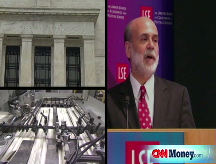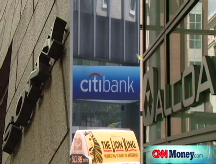Bonds rally on investor fear
Treasury prices advance as investors seek shelter amid weak retail sales, bank woes and Fed rhetoric.
NEW YORK (CNNMoney.com) -- Government debt prices rose Wednesday amid a raft of grim economic news, ongoing concern about the financial services sector and comments from a top Fed official suggesting the central bank could buy long-term Treasurys.
Wednesday's economic data was a "train wreck," which means "the fear trade is back on," according to Bill Larkin, a fixed-income specialist at Cabot Money Management in Boston. He added that the market is focused on "further deterioration in the banking sector."
Those fears helped drive demand for government debt Wednesday. Many investors buy Treasurys when economic storm clouds are brewing because the notes are considered one of the safest places to park capital.
A pair of reports on retail sales highlighted concerns that consumer spending, which makes up the bulk of the nation's overall economic activity, will drag the economy deeper into recession.
The National Retail Federation said holiday sales for the combined November-December months fell 2.8%. The trade group had originally forecast holiday sales for that period to grow 2.2%.
Separately, the Commerce Department said retail sales tumbled 2.7% last month, compared with a revised 2.1% drop in November. Economists surveyed by Briefing.com on average had forecast a decrease of 1.2% for December.
Meanwhile, Banking giant Citigroup (C, Fortune 500) said it plans to sell a majority stake in its brokerage division, Smith Barney, to Morgan Stanley. That fueled concern about fourth-quarter corporate results among banks.
"The government has put so much effort into getting banks back on track, and every quarter we get disappointed," Larkin said.
Citigroup is widely expected to report another loss when it releases fourth-quarter results Friday. JPMorgan Chase (JPM, Fortune 500), which reports results Thursday, is also expected to disappoint investors.
Larkin said the ongoing weakness in the banking sector could prompt the Federal Reserve to develop "new approaches" to get banks lending. That could include purchasing bank's illiquid assets, which was the original intent of the Troubled Asset Relief Program, he added.
Treasurys were also being supported by comments from Charles Plosser, president of the Federal Reserve Bank of Philadelphia, suggesting that the central bank is considering buying long-term government debt.
"Certainly the Fed is prepared to and is discussing it," said Plosser, speaking in Delaware, in response to a question about whether the U.S. central bank will buy long-term Treasurys, according to Reuters.
The Fed has been mulling this option as a way to bring down long-term mortgage rates by reducing the gap between interest rates on home loans and yields on government debt.
Bailout tab: The government's tab continues to grow as President-elect Barack Obama moves toward implementing a new stimulus plan based on creating jobs through reinvesting in infrastructure projects, and Federal Reserve Chairman Ben Bernanke says that further bank bailouts will likely be in the economy's near future.
On Wednesday, the government auctioned $30 billion of 8-week cash management bills. Earlier this week, the Treasury auctioned $22 billion worth of 52-week bills, $24 billion worth of 4-week bills, $26 billion worth of 13-week bills and $27 billion worth of 26-week debt.
Toward the end of 2008, government debt prices reached record heights and yields sank to record lows. The recession and the plummeting stock markets resulted in a record demand for government debt, which are perceived by most investors as the safest asset class in times of market turmoil.
Debt prices: As of 4:20 p.m. ET, the benchmark 10-year bond rose 28/32 to 113-20/32, and its yield fell to 2.2%. Bond prices and yields move in opposite directions.
The 30-year bond jumped 2-22/32 to 131-26/32, and its yield fell to 2.89%. Meanwhile, the 2-year note rose 2/32 to 100-10/32, and its yield was 0.72%.
And the yield on the 3-month Treasury bill held unchanged at 0.12%. The yield on the shorter-term note fluctuates with the confidence in the marketplace. As investors shy away from other, riskier parts of the market, they move their funds into the short-term bill, sending the price higher and yield lower.
Lending rates: Bank-to-bank lending rates have been trending lower since spiking in the fall, when the credit crisis came to a head following the fall of investment banking behemoth Lehman Brothers.
Banks virtually stopped lending to each other out of fear that they would not be able to get their loan back. With banks hoarding on their cash, the pipelines of credit that are the lifeblood of the economy froze. Lending rates spiked and businesses and consumers had a very hard time obtaining financing.
However, as the result of a slew of unprecedented government interventions, lending rates have sunk to multi-year lows.
On Wednesday, the 3-month Libor rate was 1.08%, according to data available from Dow Jones. That is the lowest level the rate has been at since June 25, 2003, according to the British Bankers' Association (BBA).
Furthermore, the overnight Libor rate was 0.10% Wednesday, according to Bloomberg.com, unchanged from Tuesday and a record low for the lending rate.
Libor - the London Interbank Offered Rate - is a daily average of rates 16 different banks charge each other to lend money in London, and it is used to calculate adjustable-rate mortgages. More than $350 million in assets are tied to Libor.
Two credit market gauges showed very modest signs of improved confidence in the credit markets.
The "TED spread" narrowed to 0.96 percentage points from 0.97 percentage point Tuesday. The higher the spread, the less willing investors are to take risks. The rate widened to historic levels as the credit market froze in the fall. As central banks around the world have eased lending rates and worked to increase liquidity in the marketplace, the spread has come back down.
Another market indicator, the the Libor-OIS spread narrowed to 0.91 percentage point from 0.92 percentage point Tuesday. The Libor-OIS spread is a measure of how much cash is available for lending between banks, used for determining lending rates. The bigger the spread, the less cash is available for lending.
How do you think Barack Obama's presidency will affect you and your wallet? What can he do to help you - and others - in these trying economic times? E-mail us at realstories@cnnmoney.com, and your thoughts could be part of an upcoming story. ![]()





